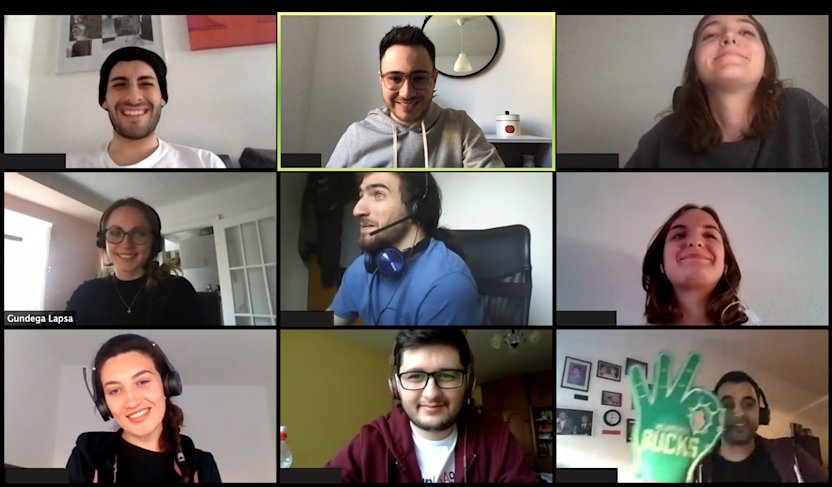
Working Remotely – Principles for Successful Team Collaboration
In my previous article, I explained how the distributed product team for Celonis Snap utilised several on-site team collaboration exercises. We met at the Pristina office and spent three full days aligning our team’s vision and defining better communication principles. By the end of the week, we had defined several action points.
Due to the current situation regarding COVID-19 coronavirus and the work from home policy, we have transitioned into a fully remote team. Remote means that none of the team members are co-located. Now more than ever, our communication is being challenged. But with the principles we defined during the workshop, we are able to stay focused and aligned.
Working remotely does not mean that the product workflow should be changed. However, it does require higher attention and structure. We've all experienced the frustration of trying to follow a video conference where five people talk at the same time. Likewise, we've also sat in front of a blank screen waiting for an attendee to join only to discover that he or she can't make it. Or even worse - drifted away during the call until silence kicked in because you missed a question.
The purpose of this article is to share our team principles in hope that it can help other remote software product teams. The principles are described in relation to product team methodologies but they are universally applicable.

Snap team during a video call
Principles
If you can not attend the Daily Standup, inform the team at least 1h prior to the call
Our development team holds a meeting each morning to communicate our progress and planned tasks. Since there are six of us scheduled for the call, it is important that we know who will attend. When you are co-located, your colleagues can tell when you're out. When working remotely, they might end up waiting for you to join. The principle of letting your team know beforehand helps to keep accountability and avoid wasting time.
TIP: Try to have positive reinforcement when everyone is showing up on time and informing the team beforehand. We learned that celebrating our successes together as a team is more rewarding than focusing on pointing out the pitfalls.
All our meetings are video calls
Yes, we have to show our faces during each meeting. This rule was defined to increase the transparency within the team. Seeing all your teammates creates a friendlier atmosphere and ensures that everyone is present and engaged (and leads to less time spent in the call).
TIP: Do not worry about your cat sleeping in the background or your pink wallpaper –in fact, it can even lighten up the team mood–. Your colleagues will focus on you. It is also a nice motivator for you to take a shower and get into your work mode.
Have a Weekly Sync meeting with the entire team
For Celonis Snap, we have a product team as well as a customer support representative and two working students. While the Daily standup meeting is for the product team only, it is important to get in touch with the rest of the Snap team members. Each week we hold a video call to sync our overall team mood and, if time is left, present anything exciting that we have worked on. This meeting helps all the team members feel that they're contributing to Snap's success and creates a safe space for team-related feedback.
TIP 1: Have a predefined structure for this meeting, and someone within the team to moderate it. While it is great to share your feelings, it might easily go off topic. Define questions that fit your team and company values but keep the openness factor. In Snap, we answer the following questions in no particular order:
How do I feel?
What new thing did I learn about myself last week?
Who did something within the team, that I'm grateful for?
What am I excited about this week?
What is my one wish?
TIP 2: Adjust the length of the meeting to whatever fits your team size so that everyone has time to speak up. Our team consists of 10 members and we spend 45min in total.
TIP 3: Personal level over work/sprint related feedback. Try not to go into depth about anything sprint-related.
Agree on a common communication tool and utilize its functionality
Communication is the key when working remotely. E-mail is not sufficient for immediate updates, so finding one main communication tool should be a priority. In Celonis, we use several team-related Slack channels for different purposes. While it is important to keep a friendly team atmosphere, it is very likely that important information will get lost amongst daily chatter and cat GIFs. In Snap, we use the @here tag (notifies all the members in the channel) to indicate when response or action from the team is required. We also have a policy for when we can expect this response (see the next point).
TIP: Only join relevant communication channels. Joining all of the available channels might feel important to stay within the loop but it might in fact hinder your productivity.
Have at least 4h of overlapping working time
People generally have varying productivity times. While some of your team members might be early birds who rise and shine at 5am, others might be more productive on evenings. Working remotely has a potential to cater for both working types as long as there are boundaries and the job gets done. In Snap, we have agreed that from 11am until 5pm we all are available. Available does not necessarily mean that we are working but that we are reachable via our communication tools. If we get tagged at @here tag after 5pm, we can respond at the next available working time. This way the morning birds do not get dragged back to their laptops at 10pm and the night owls do not wait for their response until the morning.
TIP: If your team consists of members from different time zones, spend some time to define these overlapping hours as it is crucial for collaboration.
General remote worker tips
Working from home might seem less motivating or you might feel like you can take it less seriously. This is a potential threat to the overall team productivity and your personal performance. Here are some additional tips that you can follow:
Get out of your bed.
Seriously! It seems so obvious yet we've all been there. It might be more comfortable, but try having a serious call with your flowery pillow case behind your back.
Continue getting ready as if you were about to go to work.
Because you are. Your work environment does not change your work responsibilities. Keep your trainers for extra comfort, but put yourself in a productive working mood.
Set your daily schedule.
Not only in the calendar for your colleagues to see, but for yourself. When are you going to finish the work and close your laptop? When will your last call take place? Schedule your day ahead. Try to set your mind for work during your agreed working hours and let yourself disconnect afterward.
Working remotely might pose new communication challenges, but it also creates room for flexibility and adaptability. To stay focused and productive within your team, inform your colleagues if you are running late; utilize video calls; don't forget to sync with your whole team; have a unified communications model; know when to ping your colleagues. And do not let your guard down. Stay safe and stay productive!



